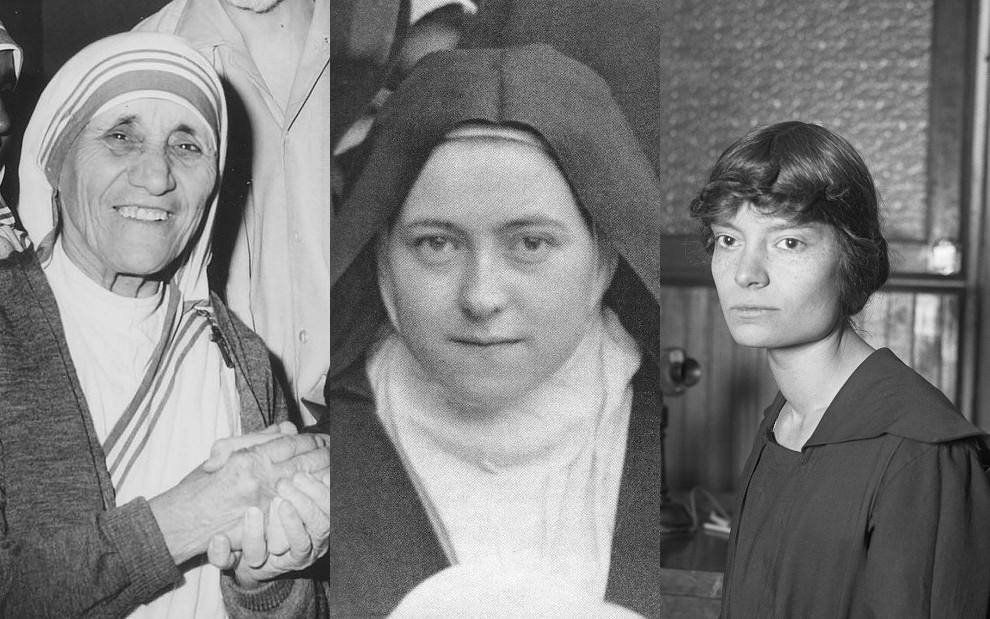The coffee mug on sale in the gift shop said it all: “Do small things with great love.” Mother Teresa. For $5.95 plus tax I could hold the key to a holy life in my hand. It was a fitting combination in a way: an ordinary object used in everyday life serving as a reminder of a spiritual truth.
Most of us would agree holiness is a good thing, but we don’t always have a quick answer to what it is or how to pursue it. Do we have to merit being called a saint, journey as a missionary to a far-off place, or make some incredible self-sacrifice?
Three modern Catholic women, Thérèse of Lisieux (1873-1897), Dorothy Day (1897-1980), and Mother Teresa (1920-1997), showed how the path of holy living can be a “Little Way” in which small, ordinary, everyday actions can lead us to a closer experience of God. As Dorothy Day, author of a book about Thérèse of Lisieux, said: “It was her destiny to show the world of today that holiness is accessible to all, that all are called, and that it is a ‘little way,’ a simple way for all to follow.”
It is with Thérèse of Lisieux, the Carmelite sister known as the “Little Flower,” that the Little Way is most associated. Thérèse never thought of herself as great. But in the paradoxical ways of the kingdom of God, she became after her death an inspiration to the world, a saint embraced by masses of people, a person Pope Pius X called the “greatest saint of modern times” and whom Pope John Paul II named a Doctor of the Church.
“I’ve always wanted to be a saint,” Thérèse said. But in measuring herself against the saints, she felt like a grain of sand compared to a mountain. She also believed, however, that God would not have given her such a desire without it being in some way possible. The key, she found, lay in accepting herself. “I’ve got to take myself just as I am, with all my imperfections; but somehow I shall have to find out a little way, all of my own.”
For Thérèse the Little Way began with receptiveness to God and total abandonment to and confidence in God. It expressed itself in the doing of little things, and in doing them with a certain intention.
“That shall be my life,” she said, “to scatter flowers—to miss no opportunity of making some small sacrifice […] always doing the tiniest things right, and doing it for love.”
I’ve got to take myself just as I am, with all my imperfections; but somehow I shall have to find out a little way, all of my own.
Thérèse of LisieuxAdvertisement
Convent life presented her with opportunities to follow the Little Way: taking care of the chapel, doing laundry, working in the dining hall, writing plays for the community, and, especially, ministering to the ill and infirm sisters with concern. In her daily tasks she tried to do all things well and with love.
“What did she do?” Dorothy Day wrote, “She practiced the presence of God and did all the things—all the little things that make up our daily life and contact with others—for his honor and glory.”
The first time Day heard of Thérèse, she lay in one of the 60 beds of the Bellevue Hospital maternity ward in New York City. She had just given birth to her daughter, Tamar, and a young mother in the next bed had asked about the new baby’s name. “Tamar Teresa,” Day said. “After the Little Flower?” No, Day replied, after Teresa of Ávila. “I had never heard of the Little Flower,” Day wrote, “and she had never heard of Teresa of Ávila.”
Dorothy next crossed paths with Thérèse some years later, after she had become a Catholic. Having received a copy from her confessor of Thérèse’s spiritual autobiography, The Story of a Soul, Day dutifully read it and was “ashamed to confess I found it colorless, monotonous, too small in fact for my notice.”
Day’s irony was probably not unintentional. After founding with Peter Maurin the Catholic Worker movement, Day would come to see Thérèse as a model for the Catholic Worker: “We should look to Saint Thérèse the Little Flower to walk her little way, her way of love.”
[Christ] made heaven hinge on the way we act toward him in his disguise of commonplace, frail, ordinary humanity.Dorothy Day
Day was acutely aware of the blessed “craziness” of voluntary poverty, serving the poor, and witnessing to peace. “If we hadn’t gotten Christ’s own words for it, it would seem raving lunacy to believe that if we offer a bed and food and hospitality to some man or woman or child […] that my guest is Christ,” she wrote in her 1945 Christmas appeal for the Catholic Worker.
In addition to being little, Day and the Catholic Workers di the little things for those they served. Day wrote, “Paperwork, cleaning the house, dealing with the innumerable visitors who come all through the day, answering the phone, keeping patience, and acting intelligently, which is to find some meaning in all that happens—these things, too, are the works of peace, and often seem like a very little way.”
The Catholic Workers lived this way “by seeing Christ and serving Christ in friends and strangers, in everyone we come in contact with. For Christ said a glass of water given to a beggar we give to him. He made heaven hinge on the way we act toward him in his disguise of commonplace, frail, ordinary humanity.”
Before she became Mother Teresa, Sister Teresa was a religious of Our Lady of Loretto who taught mostly middle- and upperclass young women of European descent in her community’s school in Calcutta. Outside the school, however, lay a vastly different reality: the squalor and misery of the Calcutta slums.
Her reading of Matthew 25:40—“Truly I tell you, just as you did it to one of the least of these […] you did it to me”—went straight to her heart, where an idea began to grow. While praying during a train ride in 1946, she became “aware of a calling in the midst of my vocation: I had to leave the convent and consecrate myself to the poor, living among them.”
Several former students followed her, and together they founded a new religious order, the Missionaries of Charity, who she said, “are firmly convinced that each time we offer help to the poor, we really offer help to Christ.”
“Holiness is not the luxury of a few,” Mother Teresa said, “it is everyone’s duty […] yours and mine.” And for her the way to holiness was a little one, beginning with God’s love in our hearts and moving out to those around us. “God has created us so we do small things with great love,” she said. “I believe in that great love, that comes, or should come, from our heart, should start at home: with my family, my neighbors across the street, those right next door. And this love should then reach everyone.”
Holiness is not the luxury of a few, it is everyone’s duty.Mother Teresa
The missionaries’ work began with helping abandoned children, teaching them basic self-care as well as the beginnings of how to read. Then one day she found a woman dying in the street. She took her back to the missionaries’ house and gave her a bed in which to die with peace and dignity. This action led Mother Teresa and the missionaries to establish the ministries for which they became famous and that earned her a Nobel Prize: homes for the dying, abandoned children, lepers, AIDS sufferers, and unwed mothers.
Mother Teresa also had a remarkable feel for spiritual as well as material poverty. “Do we know the poor in our own homes?” she asked. “Sometimes people can hunger for more than bread. It is possible that our children, our husband, our wife, do not hunger for bread, do not need clothes, do not lack a house. But are we equally sure that none of them feels alone, abandoned, neglected, needing some affection. That, too, is poverty.”
Day after day she and her sisters and their helpers gave comfort and dignity to the most afflicted, those not only sick, dying, or in other extreme circumstances but also abandoned and forgotten. The sisters’ actions showed these people that their lives mattered to others and to God.
Thérèse of Lisieux, Dorothy Day, and Mother Teresa show us that the call to holiness is one we can all answer, and we can answer it through everyday tasks and relationships. To encounter others with respect; to see Christ in everyone we meet; to do everything, even the smallest of tasks, with devotion and love; to do the generous thing when we could settle for only taking care of ourselves; to respond to the material and spiritual poverty of those around us—all these actions bring us closer to God, and to the holy.
This article also appears in the November 2005 issue of U.S. Catholic (Vol. 70, No. 11, pages 42-43). Click here to subscribe to the magazine.












Add comment